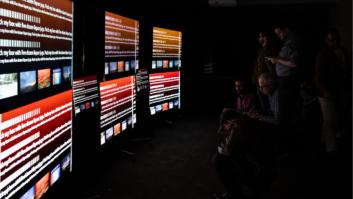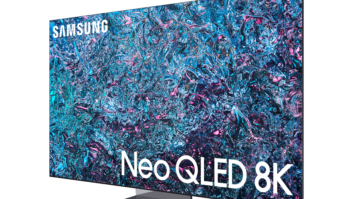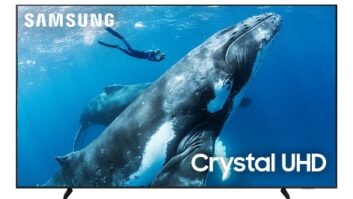It may seem premature in August, but now is the time to consider what your vendors will try to convince your customers to place under the Christmas tree this year.
With the requirements of the FCC’s tuner mandate now underway, manufacturers will finally begin to offer “integrated” sets that include ATSC tuners as well as traditional analog (NTSC) tuners. More manufacturers will also offer QAM tuners that enable the unit to tune in digital cable, but remember that without a CableCard slot the set will be limited to “in the clear” digital channels, and those are few and far between.
Remember the equation NTSC + ATSC + QAM + CableCard + HDMI = Digital Cable Ready. In other words, to assure the customer that the set they are about to purchase (and hopefully which you will install and integrate into their home entertainment system) will be able to tune in just about anything that is available over-the-air, you will need to make certain that the DCR logo is there.
Trying to go from “zero to 60” in no seconds flat, DCR wasn’t even available last season. This year you will see it in a wide range of models and products from all the major brands. Virtually all of the majors will have it in RPTV models, leaning more toward microdisplay than CRT-based sets. There will be a smattering of DCR direct-view sets, with Panasonic, Sony and Pioneer among the few brands that extend DCR to plasma display panel (PDP) sets. As of this writing there hasn’t been a firm sighting of a direct-view LCD set with DCR, but don’t be surprised if that happens within the time window from when this article is written and when you hold the issue in your hands.
Given the lead time and technology needed to implement the full DCR feature set, if you are looking for some level of advanced connectivity you may have to satisfy customers with sets that offer some of the components of DCR, but not all of them. For example, virtually every digital and “digital-ready” set in the market this fall will offer at least a DVI connection with HDCP. Going forward, this will be enough to connect to cable boxes or other set-top sources for digital video. HDMI is nice, but rarer. Remember, of course, that DVI is interchangeable with HDMI at least in so far as the video side of things is concerned. If you are looking for full connectivity with digital audio output of HDMI-equipped DVD, DVD-Audio and SACD optical players, DVI won’t foot the complete bill. Otherwise it is still well within reason to offer sets with DVI, only as long as there is HDCP capability.
A word of caution, however, is to remember that you should be careful about over-promising on any connectivity scheme, even DCR. A good example is the fact that current DCR and CableCard sets are one-way only, as the standard for two-way interactivity has yet to be finalized. That means that for the customer who is heavily into video-on-demand, a better bet would be one of the sets, again from most of the major brands, that offer 1394 so that a digital connection to a cable set-top is possible.
Another reminder: although it has been required for more than a month now, it is likely that your installation staff or your clients will encounter a blank stare or long silence when asking the customer service representative for an HD cable set top with 1394. It may take a bit of explaining and quite possibly a request to be transferred to a manager or supervisor to find your answer.
Yet another reminder in all of this is that front projectors, which traditionally have video inputs only and rarely a tuner of any type, are immune from the tuner mandate since, well, they don’t have any tuners. Here, connectivity is more of a point of interest; front projectors with DVI are becoming more popular, but many of those have DVI-I and no HDCP, as opposed to DVI-D with HDCP. At this point, HDMI in a front projector is extremely rare to non-existent. Perhaps that, too, will change after the introductions at CEDIA EXPO next month.
Once you get connected, what will be used to power the light engines of the new sets? The change that began ever so slowly a number of years ago with the first DLP and LCD rear screens has now become a full-fledged bandwagon. Broadly categorized under the moniker of “microdisplay,” DLP, LCD and LCoS will be in almost every brand’s line up this year. The interesting thing, however, is that some brands have changed their alliances so that depending on which technology you favor, the choices have changed. Toshiba and Thomson’s RCA, for example, had both made early efforts to make good on the promise of LCoS, but for this fall they are both firmly and broadly in the DLP camp with a wide range of models. Indeed, some time before the end of the year both RCA and InFocus (RCA’s technology partner in the project) will ship DLP-based RPTV sets that are less than seven inches deep.
Also in the DLP camp in a big way is Mitsubishi, though they will continue to offer their “world’s largest RPTV,” an 82-inch-wide LCoS-based model. Samsung, which has done as much as any other brand to establish the viability of DLP as a technology behind rear-screen projectors, will continue those efforts this fall with sets that will offer just about every variation of the Texas Instruments technology. “Popularly priced” sets in their 63 Series will use TI’s new HD3 imagers, while the upscale 85 Series will feature HD2+ chips. Things will get interesting in the late fall when Samsung starts shipments of the first RPTV sets that use the xHD3 devices to deliver native 1080P displays from a DLP powered consumer product for the first time.
Despite the popularity of DLP and some notable defections from LCoS to DLP, LCD-based imaging remains the power behind some big-brand RPTV sets. Notably, Sony, Hitachi and Panasonic are continuing to lead the LCD charge, along with Epson and its unique LCD-powered sets that feature built-in photo printers. Indeed, though you and your clients may associate technological innovation in solid state imagers with DLP, LCD is not taking a back seat to the new upstart. Hitachi is among those taking LCD light engines to the next level with improved optics and integrated systems that place the chip/prism/lens system in such a way that the cabinet height is reduced, a twist that may be useful in some applications, and differentiated from the reduced cabinet depth that has been the holy grail for microdisplay-based sets.
The last leg of the microdisplay triad is LCoS, which has gotten a bit of a bad wrap due to some of the false starts noted above. However, LCoS is far from out of the picture and for all the attention given to DLP there may well be an LCoS renaissance this year. Pointing the way is JVC, whose D-ILA systems are an LCoS variant. JVC will be offering a quartet of three-chip D-ILA sets with 1280×720 resolution, two with DCR. While most LCoS and LCD sets have indeed been three-chip systems, not shy about pointing out the artifacts sometimes associated with the single chip/color wheel DLP systems, Philips continues with a single-chip LCoS engine using what is now the third generation of its Cineos models. All five (in three screen sizes) are 720P. DCR is still in the works for Philips, and it will appear first in that brand’s CRT based RPTV models.
A newcomer to branded products, but not to LCoS technology is Brillian, one of whose primary businesses is to manufacture the actual LCoS chips and light engines used in projection televisions. While their ultimate goal is to sell “raw chips” and possibly light engines, they have taken an interim step of commissioning 720P RPTV sets to be sold under their own brand name to demonstrate the viability of LCoS technology. It will be interesting to see what type of take-up this new brand gets in the custom marketplace, where brand identity is important, but image quality and the ability to integrate products into unified systems that are not sold simply on price is important.
Before leaving LCoS, it is worth a final note that the newest LCoS-based technology, Sony’s SXRD, is scheduled to move beyond limited availability in the Qualia front-screen projector at some point before the end of the year. Sony executives have said only that there will be some SXRD news involving rear-screen sets at CEDIA EXPO.
Moving from projection to direct-view, “plasma” has almost become a consumer catchall for flat panel displays, making it more important for salespeople to explain the difference between PDP and LCD to consumers. That having been said, plasma will likely continue to be the only choice in sizes over 60 inches wide, with the possibility that we will see at least one PDP over 70 inches wide with 1902×1080 resolution in limited distribution this year. Beyond that, it looks as though PDP sizes will remain at their current 32-, 37-, 42-, 46-, 50-, 61- and 63-inch dimensions and ED resolution at 42 and 46 inches, with HD resolution elsewhere.
As noted above, there will be some DCR-equipped PDP models, with a wide variety of brands offering a wide variety of configuration options with regard to connectivity and features. And, to make life interesting, there will almost certainly be intense price competition not only from “new/old” brands but also continued pressure from computer brands who will once again put pressure on you with pricing for PDP that can only be answered by intelligent system packaging and value-added services by those of us in the specialty retailing and custom installation world.
When it comes to LCD, things are always subject to change at any moment. Among those “things” are the brands that offer LCD, the sizes of the product offerings and the pricing for all of that. As new LCD fabs come on line in Japan, Korea and most importantly Taiwan, you will not only see that capacity translate into larger size panels, you will see more and different brands as well as the almost inevitable pricing pressure.
Economic pragmatism says that even the over-50-inch size panels shown as prototypes at CES in January will continue to be elusive through the end of the year. On a more practical level, expect 45-, 46- and 47-inch-wide sets to be the largest readily available sizes through the “season,” at premium pricing that will likely hover at or just under the $10,000 mark. Though smaller than similarly sized plasmas, these new LCDs will all offer full 1080P resolution, which is not yet available in PDPs under 70 inches.
Thus, your choice of whether to specify an LCD or PDP for a given application becomes an interesting one. If the size requirement is 50 inches wide or more, or 30 inches wide and under, then PDP is best for the former and LCD being absolutely the only answer for the latter. In that middle sweet spot, however, the decision as to where to guide a client or prospect is where you really earn your keep and profit. Consider all of the factors: Product life span? (Given adherence to appropriate operating conditions, the result is close to a draw). A requirement for DCR? (Advantage PDP). A high altitude situation? (Advantage typically to LCD). The need to display static images and not have burn it? (Advantage LCD). Response time? (Still a slight to moderate advantage to PDP). Lighter weight and less heat? (Advantage LCD). Everything else, from image quality to resolution to availability of models with built-in tuners to bezel styling to input selections and much more, becomes a matter of both technology and brand.
Before concluding a rundown of new model display products it would be inappropriate to totally ignore CRT. CRT-based displays continue to provide the value option for both rear-screen projectors and many direct-view applications.
In RPTV it is easy to be entranced by the modernity and slim design of microdisplay, but when it comes to more budget-sensitive installations, CRT-based products continue to provide value from a price standpoint, and they remain the benchmark for image quality. Those looking for either digital-ready or fully integrated DCR models will find a wide variety of options in CRT-based products from all the major brands with the exception of Pioneer. Pioneer is concentrating on PDP going forward, and exiting from CRT without taking the microdisplay plunge.
On the direct-view front, it becomes a matter of size, as well as price and resolution. While CRT sets will continue to be available for HDTV applications in both 4:3 and 16:9 configurations, it would appear that CRT’s place may begin to narrow to smaller sizes where LCD cannot compete with LCD for pricing in the under 13 inch-size categories. Yes, there are certainly small LCD sets, and where their pricing is not a barrier they are certainly the way to go. In other applications, however, it would be foolish to ignore CRT for places where it is the proper match.
One interesting note for display applications would be to mention the availability for delivery (and without a doubt your installation) of Philips’ MiraVision in time for jobs that you take on for completion before the end of the year. Shown previously in prototype, but now available as production products, MiraVision integrates a 17- or 23-inch-wide LCD with a special polarized mirror that allows close to 100 percent of the light output of the display to show through when the “mirror TV” is on, and for it to completely disappear into the large mirror when the set is off. This is clearly a specialty item, but for jobs and applications that can carry the pricing ($2,799 to $3,999) this is something that will mark the client’s house as unique.
Michael Heiss ([email protected]) is a technology and marketing consultant based in Los Angeles.







